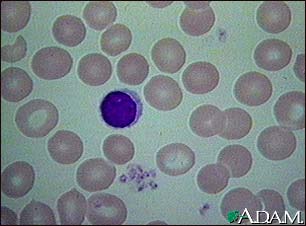Alternate Names : Hereditary spherocytosis, Spherocytosis
Definition
Congenital spherocytic anemia is a disorder of the surface layer (membrane) of red blood cells. It leads to red blood cells that are shaped like spheres, and premature breakdown of red blood cells (hemolytic anemia).
Overview, Causes, & Risk Factors
This disorder is caused by a defective gene. The defect results in an abnormal red blood cell membrane. The affected cells have a smaller surface area for their volume than normal red blood cells, and can break open easily. Having a family history of spherocytosis increases the risk for this disorder.
The anemia can vary from mild to severe. In severe cases the disorder may be found in early childhood. In mild cases it may go unnoticed until adulthood.
This disorder is most common in people of northern European descent, but it has been found in all races.
Pictures & Images
Red blood cells, normal
 This photomicrograph shows normal red blood cells (RBCs) as seen in the microscope after staining.
This photomicrograph shows normal red blood cells (RBCs) as seen in the microscope after staining.
Red blood cells, spherocytosis

Spherocytosis is a hereditary disorder of the red blood cells (RBCs), which may be associated with a mild anemia. Typically, the affected RBCs are small, spherically shaped, and lack the light centers seen in normal, round RBCs.
Blood cells

Blood is comprised of red blood cells, platelets, and various white blood cells.
-
Congenital spherocytic anemia : Overview, Causes, & Risk Factors
-
Congenital spherocytic anemia : Symptoms & Signs, Diagnosis & Tests
-
Congenital spherocytic anemia : Treatment



Review Date : 1/12/2009
Reviewed By : Todd Gersten, M.D., Hematology/Oncology, Palm Beach Cancer Institute, West Palm Beach, FL. Review provided by VeriMed Healthcare Network. Also reviewed by David Zieve, MD, MHA, Medical Director, A.D.A.M., Inc.
do not constitute endorsements of those other sites. © 1997- 2010 A.D.A.M., Inc. Any duplication or distribution of the information contained herein is strictly prohibited.
